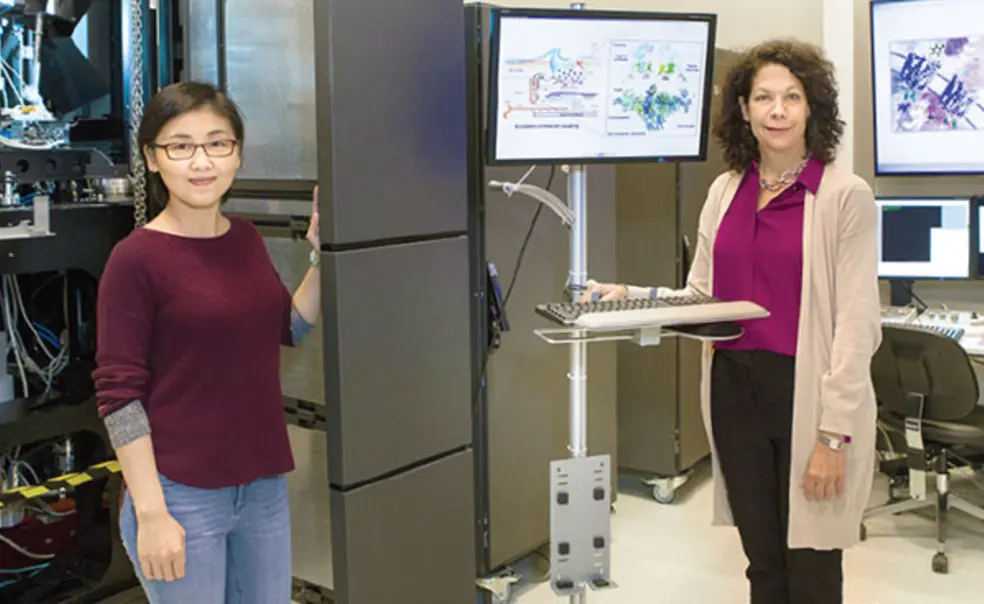Bringing a “Resolution Revolution” to Princeton
Among the many joys of my job is learning from Princeton’s brilliant faculty members. Conversations with department chairs are often fascinating because they illuminate the research that defines fields today as well as people and paradigms that will shape disciplines for years to come.
One recent example occurred when Squibb Professor of Molecular Biology Bonnie Bassler, chair of the molecular biology department, identified a unique opportunity to recruit Nieng Yan, an acclaimed structural biologist who earned her doctorate from Princeton and is now one of the world’s foremost experts on cryo-electron microscopy (cryo-EM). In early conversations about the recruitment, Professor Bassler made a compelling case for the importance of cryo-EM to the future of the life sciences at Princeton.
Cryo-EM is a revolutionary technology that uses an electron microscope to produce high-resolution, three-dimensional images of biological molecules like proteins, DNA, and RNA. Professor Bassler predicted that cryo-EM was poised to transform biological research in the 21st century. Others clearly agree: cryo-EM has already begun to make such a transformational impact that its creators won this year’s Nobel Prize in Chemistry.
Biologists have long sought to understand the atomic structures of biological molecules, but previous methods have faced crucial limitations. Cryo-EM is groundbreaking because it enables scientists to determine the structure of large and complex molecules.
The new technique is a valuable supplement to the work already happening in our molecular biology department. The department is among the best in the world at studying biological machines, the large molecules that help cells to perceive and respond to their environments. To stay at the forefront of scientific discovery, Princeton needed to secure this technology and recruit a cryo-EM expert at once.
Professor Yan’s reputation for pioneering research using cryo-EM made her the perfect candidate to anchor our program. But we faced a significant challenge. She already had access to a cryo-EM machine, a technology we weren’t yet equipped to provide. In order to bring her to Princeton, we needed to acquire a cryo-EM facility.
Recognizing the potential impact that Professor Yan and cryo-EM could have on our campus, Professor Bassler formed an interdisciplinary partnership with Emily Carter, then-director of the Andlinger Center for Energy and the Environment, and Craig Arnold, director of the Princeton Institute for the Science and Technology of Materials (PRISM). Together, they developed an imaginative plan to house the machine within the stunning, new Andlinger Center.
Accommodating the instrument in the Andlinger Center made sense because it has applications relevant to engineering, energy, and the environment. Its placement also allows for an efficient use of space—already specifically designed for electron microscopy instrumentation—while leveraging the existing technical expertise of our extraordinary PRISM staff. The resulting multi-departmental collaboration is what Bonnie Bassler calls, “one of the things I am most proud of as chair of this department.”
With a suitable location for the machine identified, funding became the next hurdle. The generosity of our alumni allowed us to act swiftly, demonstrating once again how Annual Giving provides Princeton with its “margin of excellence.” These unrestricted funds gave us the flexibility to invest rapidly in this critical new initiative. Timing was key because demand for these machines has skyrocketed. Being early adopters of revolutionary technology is crucial to Princeton’s mission of excellence because it enables us to recruit and retain spectacular scientists like Nieng Yan, who now holds an especially distinguished title here: she is the University’s first Shirley M. Tilghman Professor of Molecular Biology.
She will continue her world-leading work characterizing the structure of membrane transport proteins. Our molecular biologists tell me that these proteins regulate the flow of chemicals between the inside and outside of the cell, thereby controlling vital biological processes like neural activity and muscle contraction. The study of these molecules has been transformed by what Professor Yan calls a “resolution revolution” ushered in by cryo-EM.
The new machine’s interdisciplinary applications extend to the study of bioengineering and beyond. Professor Celeste Nelson, director of the program in engineering biology, and Cliff Brangwynne, associate professor of chemical and biological engineering, are just two examples of our leaders in this field. Faculty in the Andlinger Center will also harness the machine’s capabilities to study soft matter with applications ranging from battery materials to biofuels.
Part of the genius of locating this facility in the engineering school is that serendipitous interactions across disciplines will be a natural outcome, spurring even greater research innovation. According to Emily Carter, now dean of the School of Engineering and Applied Science, this concrete linkage between molecular biology and engineering matters because, “The problems of the 21st century are complex and aren’t going to be solved by a single discipline, and biological engineering will be a central contributor to many of their solutions.”
This type of interdisciplinary collaboration will be a vital feature in our ongoing quest for excellence. It’s only fitting that a unique partnership has animated this process from ideation through implementation. I enthusiastically agree with Craig Arnold, who remarked that this inspiring outcome exemplifies “the best that Princeton has to offer.”











1 Response
Byron T. Gorres *64
7 Years AgoVery interesting. In the...
Very interesting. In the old days of Patterson maps (the 1960s), X-ray crystallography led the way in molecular structure determinations. Now this new technique will revolutionize the science.